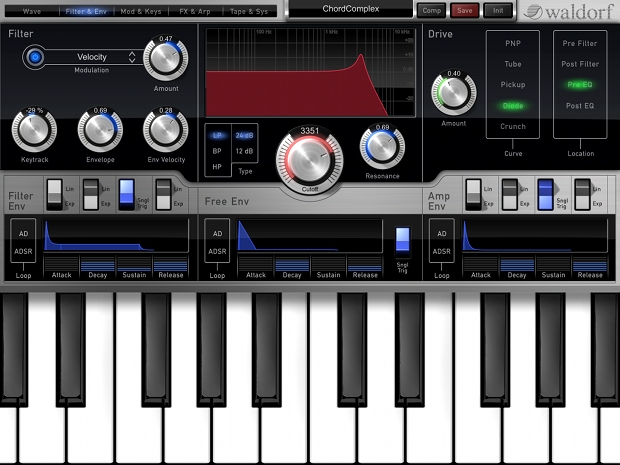
Waldorf has released an update to Nave, its software synthesizer for the iPad.
Nave was created by Waldorf chief engineer and director Stefan Stenzel, NLog mastermind Rolf Wöhrmann and synth design guru Axel Hartmann.
Here’s what’s new in Nave 1.4:
- Poly Aftertouch & Channel Pressure from external Controllers
- Native 64bit support for iPad Air & iPad mini retina
- Manage Audio Buffer Size in iOS Settings app
- AudioBus SDK updated
- Bug Fixes
Here is s demo sound video for Nave:
Nave is available in the App Store for $19.99.
If you’ve used Nave, let us know what you think of it!

Nave is one of the best synth apps. And the polyphonic after touch works great with my Qunexus.
agreed.
i’m excited to try it with my mpc 1k.
We are waiting for vst !
Now and again I consider buying a Blofeld. Nave is making me wonder if I shouldn’t just “dedicate” an iPad Mini to Nave instead. It’d be about half the price (compared to a desktop Blofeld with the sample memory unlock purchase).
Strange world we live in nowadays.
The retina iPad mini is a great option – its performance is very close to that of the iPad Air.
Isn’t an iPad mini bit of a non-starter for music apps, especially synths, given the size of the touch targets is generally quite small?
The full-sized iPad is probably better as a control surface (bring on the 27″ touchscreen music apps!) but the mini is certainly usable for most apps. I guess it depends on the app and the size of your fingers (cue Steve Jobs’ sandpaper comment.) 😉
However, if you use an external controller (preferably one with polyphonic aftertouch!) the mini should work brilliantly as a sound module.
I have both. The Blofeld gives you a second filter, way more modulation options, higher polyphony and multitimbrality, among other things.
Nave is amazing though- definitely one of the best for iOS.
Big improvement on an iPad Air, startup is really fast now and switching presets is instant.
Polyphonic aftertouch is awesome on the iPad with the CME Xkey (turn the delay and minimum note length down) and KMI QuNexus. (And in the analog world, the Prophet ’08 also accepts polyphonic aftertouch!)
It’s definitely time for more keyboard manufacturers to step up to the polyphonic aftertouch plate!!
I like this kind of app…but if they dont start to add program changes to change instruments from a daw…it will be only a good app for production…i want to play it live !!!! Same problem with animoog
Hardware manufacturers seem to know how important a complete, high-quality MIDI implementation is – we need to keep reminding app developers how important it is for music apps!!
Hi
Nave reacts to program & bank changes in this way: The bank chooses the Nave bank counted from top to bottom, the program chooses the program from the uncategorised list in Nave also from top to bottom.
Best
Rolf
Love Nave and Rolf’s dedication to adding polyphonic aftertouch to all the synths he’s responsible for (iSEM, NLog, Nave). The implementation is perfect and as opposed to many other synths that choke on the amount of MIDI data coming out of an Eigenharp, this one is working perfectly. There’s a little chance that he’ll also add voice-per-channel MIDI support, that would really be awesome!
Wait, iSEM is “made” by that guy???
That could explain why it sucks so much less than iMini (the last update effectively killed the usefullnes of iMini: FU Retronyms!)
Just check in the info screen of iSEM 🙂
I’m gradually warming up to the idea of an iPad as synth module. I don’t feel any real need for one, as I have plenty of softsynths now, but at some point, I can imagine a crossover point where the state of pads in general and some serious wowser like this will get me to take the leap. In amusing way, its grinding my natural @$$ as a pianist to be playing synths with a 2-octave XKey part of the time and likin’ it, but if you’re going to synthesize at all, the operative word is flexibility. Nave sure is a powerful draw to the platform.